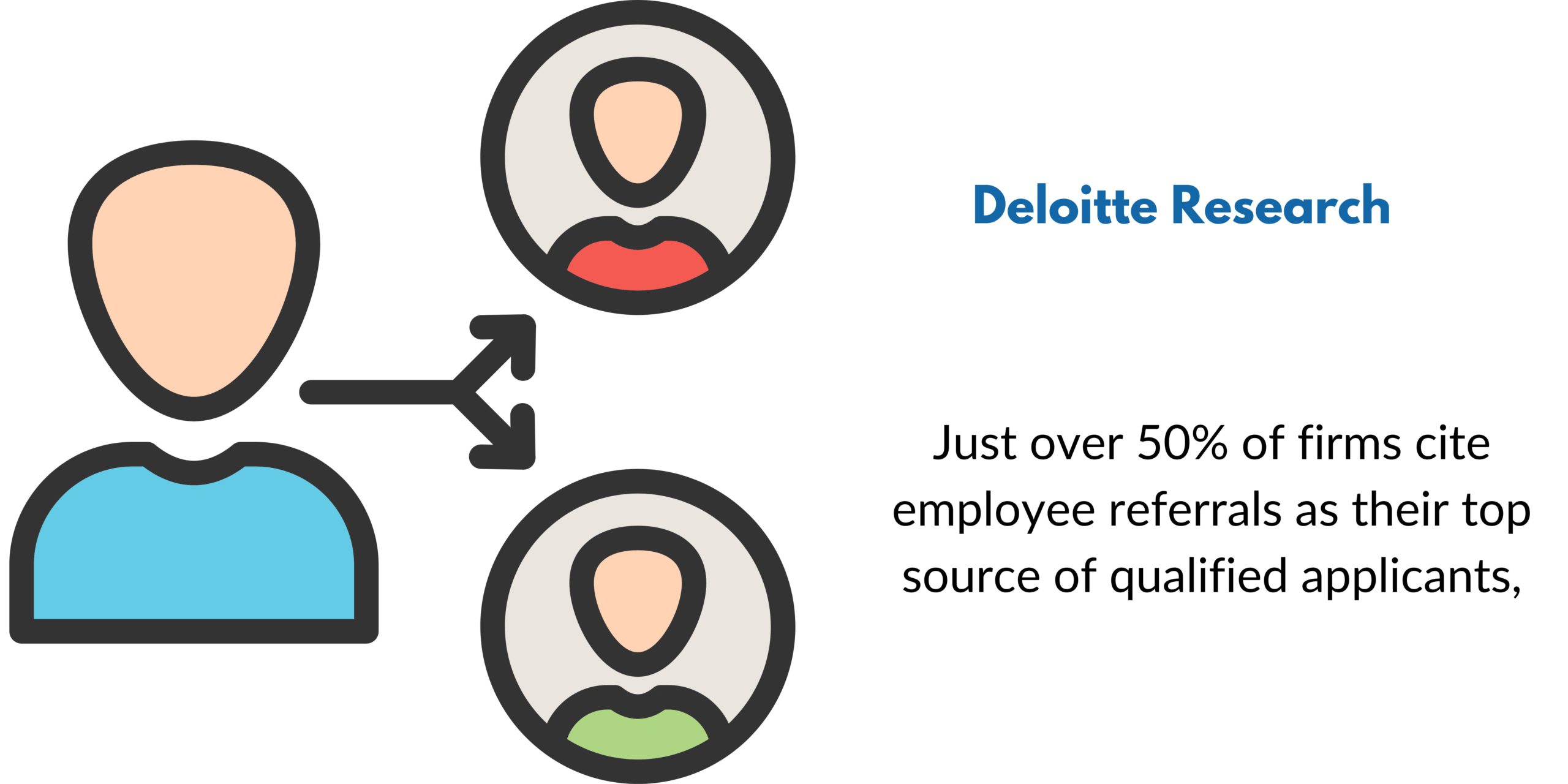The Art of Employee Referral Programs
Subscribe to the Newsletter
Candidate-driven markets need a proactive method of hiring. Just over 50% of firms cite employee referrals as their top source of qualified applicants, according to Deloitte research.
Employee referral programs can be the answer for companies that are having trouble finding and keeping skilled workers with the necessary abilities. We’ll delve into what an employee referral program is, how it helps businesses, offer some advice on how to design your own, and discuss why you need one right now in this article.
What is an employee referral program?
Employee referral programs use internal resources and networks to identify potential new hires. They offer some kind of reward in exchange for existing staff members or external partners’ recommendations for job positions as they become available.
Employee referral programs establish an organized environment that actively promotes suggestions as opposed to random recommendations. Incentives, internal communication techniques, and support and direction from the recruiting staff are frequently used to achieve this.
Employee referral programs aim to improve the sustainability and dependability of inbound referrals as a source of gaining candidates. When executed properly, these programs rank among the most fruitful and successful hiring tactics accessible to hiring teams.
We’ll go into more detail about the advantages of implementing a workable employee referral system in the following section.
Advantages of employee referral schemes

Employee referral/recommendation systems are among the most effective ways to uncover talent, as was previously mentioned.
The rising competition for great talent has reached an all-time high in recent times. To find the top prospects, firms have been forced to rely more on unconventional sourcing strategies. One such strategy that produces better results and gives more direct access to top people is the use of internal networks.
Candidates (particularly those with high skill levels) now have a slew of options, a variety of job research and networking resources at their fingertips, and the chance to work from home for businesses all over the world. These employee referral programs are a must-have strategy for the majority of hiring teams since each of these factors puts pressure on conventional sourcing methods.
Employee referral programs’ main advantage and significance is their capacity to use available resources to focus on applicants most likely to match the organization’s culture and have a positive effect on it. They give your staff the tools they need to spread the word about your business to their contacts and have them rewarded for doing so.
Commonly used key hiring indicators can directly benefit from an ordered approach to employee referral programs that make use of tracking, refinement, and internal communications best practices.
The KPIs (key performance indicators) given below demonstrates this very well:
- Time to hire: Employee recommendations remove or significantly cut down on time spent finding new candidates. By removing time-consuming outreach operations, they enable recruiters to begin their candidate search far deeper down the application funnel. Employee recommendations often result in new employment after 29 days, as opposed to 39 days for job boards.
- Expense per hire: Because they can cut back on active sourcing, recruiters can cut costs on things like advertising and job boards. Additionally, prescreened by current employees, referred applicants take less time and effort to determine suitability. Employers say that up to 82% of referrals provide the highest returns on investment and save on average $3,000 each hire in recruiting expenses.
- Hire quality: Referrals are given by current workers who are intimately familiar with your company culture and the kinds of candidates you’re seeking. Therefore, they’ll suggest persons who will do well in this setting. Since being qualified is a crucial component of a quality hire, recommendations are a crucial tool to ensure success.
- The retention rate for employees: As has already been mentioned, hiring well results in higher staff retention. New recruits are probably going to stick around for the long run if you make the best hiring decision based on performance and fit. Referrals ensure these two factors are considerably more trustworthy and consistent than hiring anonymous candidates from job listings.
- Employee referral programs are a great way to engage with passive applicants and create a pipeline of top talent while also easing the hiring process. Employees may become fantastic hires down the road if you have conversations with them about your firm, even if the ideal prospect is not particularly looking to leave.
- They support the development of your company brand: Employees who become brand ambassadors for your business will disseminate genuine, social-proofed messages about your culture and workplace. This sends the industry a strong message that you are a great employer and deserving of consideration when new talent is looking for new opportunities.
Since we’ve established the benefits of having an employee referral program, let’s move on to some key tips for setting one up.
Tips for establishing a program for employee referrals
It’s crucial to comprehend how employee referral programs normally operate before developing your own. Let’s examine a typical employment referral procedure that most recruiters are probably already aware of.
Here’s the process of employee referrals:
- There’s a job opening that appears.
- Based on the position’s needs and cultural fit, a suitable applicant is identified.
- The hiring team issues a call for references for this particular position posting.
- Employees can notice and acknowledge new job openings on the job board as the program gets more established.
- Employees conduct network searches to identify qualified individuals, then approach them to share about the organization and opportunity.
- If an applicant is interested, they email their résumé to their contact in the organization, who then gives it to the recruiter and hiring manager. The applicant then gets past the first part of the hiring process.
- Following submission, the recruiter enters the referral in their preferred employee referral program, giving the employee much-deserved credit.
- The hiring manager and recruiter do their customary screening of the recommended prospect, typically beginning with the in-person or phone interview stage.
- The candidate will receive an incentive or reward for making an employee reference if they are successful.
This is a basic illustration of how a successful employee referral program may operate. The same process can be used to fill any suitable job vacancy.
Essential factors
Although it could appear that establishing an employee recommendation program is the key to getting better employees, there are some important factors to take into mind before you get started, including:
- Employee referrals must compliment your current hiring approach: The goal of referral programs is not to replace all of your hiring efforts. Additionally, it shouldn’t be carried out via an isolated approach. Ensure all your hiring strategies are directed towards achieving that goal and concentrate on the actions that produce the best outcomes.
- Decide when to request referrals: Employee referral programs must include effective internal communication. Ensure your staff has specific instructions on when and how employees should be referred. Additionally, not all job opportunities will be good choices for referrals, which is both feasible and likely. In these circumstances, you might wish to keep active sourcing and open up some opportunities to referrals for others.
- Ensure that it complements your hiring objectives: You probably have particular KPIs or employment quotas that must be met every quarter or year. Metrics related to hiring diversity or the number of recruits may be included. In these situations, it’s crucial to assess the effectiveness of your current employee referral program with other hiring strategies to see if it aligns with your objectives. If not, it may be time to revamp your referral program or adopt a different approach to hiring.
- Review your current employee referral program frequently. Employee referral schemes are not a hire-and-forget strategy. Like other techniques, their effectiveness depends on ongoing auditing and improvement. To make sure your plan is still effective, review your referral KPIs on an annual, quarterly, or monthly basis. It’s a good idea to adjust your strategies if things begin to go awry. Let’s go into some specific elements you’ll need to address when developing your own structure now that we’ve built a decent employee referral pipeline and some important factors to be mindful of.
Key Elements

Generally speaking, an employee referral program’s essential elements are:
- Communications
- Rewards
- Metrics
- Refinement
Let’s examine each in more detail.
Communications
Communicating the existence of goals and processes for your employee referral program to your employees should be your top priority. Without this internal comms strategy, your program will likely fail before it begins.
There are two categories of communication tactics to take into account:
Ongoing communication: This develops a predictable rhythm for employee outreach. In these situations, recruiters will send reminders out about whichever employee referral program is used on a monthly or quarterly basis, detailing how it operates, what the benefits are, and which roles are covered. This ensures employees have it at the forefront of their minds and inspires persistent effort from personnel.
Callouts for particular roles: This is for whenever a high-priority vacancy becomes available. These communications will typically outline the position and ideal applicant while also reminding staff how to send referrals. Try out various internal communication strategies to determine which is most well-received by your staff. Never be reluctant to seek advice or criticism to improve your work.
Finally, ensure all your interactions with employees are particularly inclusive. Regardless of their level of seniority, ask all members of the workforce for recommendations or referrals.
Rewards
You’ll need to offer a perk or two to encourage referrals from your staff. Although incentives or rewards can take many various forms, employee referral bonuses often work the best. Your primary driving force in building a consistent pipeline of reference applicants would consistently be the financial incentive.
Other suggestions for employee referral incentives include:
- Vacation time
- Show or event tickets
- Gift cards for food and beverages
- Holidays or trips
- Social acceptance
An employee referral program will often produce better outcomes, the more alluring the prize.
Metrics
Launching a new employee referral program without first establishing what success looks like is something of a fool’s errand. The same can be said for virtually any recruitment tactic.
It’s crucial to decide your objectives for your employee referral program and the corresponding metrics. This could incorporate:
- Total number of referrals
- Total number of hired referrals
- Total number of referrals by department or function
- Percentage rate of retention for referred personnel
- Performance indicators for recommended workers
You can gain a clear understanding of how well your employee referral system is functioning over time by tracking these indicators. Additionally, it will aid in the final phase of refinement.
Refinement
You can gradually raise your key performance indicators by actively assessing and improving your employee referral program, as is done in agile recruitment.
Create a schedule for your referral program’s periodic reviews. Compare your KPIs to your quarterly or annual targets, and pinpoint any areas that could need improvement. Doing this may prevent your results from plateauing over time and ensure you’re always ready to adjust to emerging internal and external changes.
Employee referral programs are a great strategy for optimizing results while conserving resources, as was stated at the beginning of this article. Your finest asset is your workforce, which, when needed, will contribute to the advancement of the business. All you need to do is ask!